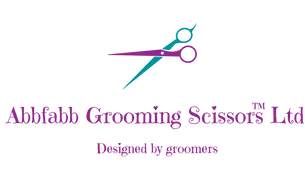'Why do dog grooming scissors catch, lock or jam?'
This is a frequently asked questions by many dog groomers, including dog grooming beginners and are just started out their career in the dog grooming industry. Learning how to hold and use dog grooming scissors is a very important part of training to become a dog groomer and moving forward into the dog grooming industry. The correct thumb and finger positioning is part of a vital care regime to ensure that the scissor performs as it should and lasts for a long time.
What is catching, locking or jamming of dog grooming scissors?
This is the action is where one blade will catch or lock against the opposing blade of a dog grooming scissor. This issue is a fairly common occurrence for scissors with teeth, such as the blending dog grooming scissors, thinning scissors, fluffers, chunkers and texturising scissors. However, it is still possible for it to occur with straight or curved dog grooming scissors.
Why does the catching or locking occur?
Correct thumb and finger positioning.
It is important for a dog groomer not to place more than the tip of their thumb in the thumb hole. The reason for this is that the human hand is designed to 'grab' objects and hold them securely. Once the thumb is engaged with an item, it will naturally 'grab'. So with regards to dog grooming scissors, this 'grabbing' action generate a large and unnecessary amount of pressure on the bottom blade, forcing it directly up against the top blade. This pressure will force the blades to grind against one another and will result in the blades catching or locking completely.
As the cutting edges of the dog grooming scissors are extremely sharp, the small amount of pressure applied from the tip of the thumb is more than enough to enable the blades to glide smoothly across and efficiently cut the coat.


This action will cause the teeth to lock or catch up against the top blade and as a result, this will create a dent or dents along the cutting edge of the blade.

These dents will prevent the blades from closing smoothly and effectively making the scissor unusable. If the dents occur and the blades will not close, it is advised that the dog groomer should contact a scissor sharpener and have the dents removed professionally.
It is important to note that whilst using any dog grooming scissor, only the thumb should be moving and operating the scissor. The fingers are there to help support and keep the scissors in the correct position.
 or
or 
Examples of Correct Thumb Positioning.
The correct finger positioning is also an important role in the dog grooming scissor being used correctly and helps keep the thumb supported and in the correct place in the thumb hole.


Incorrect Finger Positioning vs Correct Finger Positioning.
Below are two links from the Abbfabb Grooming Scissor Ltd website which provide a free visual demonstration on how to hold a dog grooming scissor and the correct thumb and fingers placements.
How can a dog groomer keep their thumb and fingers in the correct position?
As every dog groomer has different sized thumbs, fingers and knuckles, maintaining the correct thumb and finger position in the finger holes can be difficult. However, the art of the correct finger positions can be mastered with regular practice either in or out of the grooming salon.
It is advised that those who are about to start to or are on their dog grooming training course, practice regularly (ideally away from the salon or training school) keeping their thumb and fingers in the correct places. This practice will help build muscle development in the thumb, as this is the digit which operates the blades, and muscle memory for the fingers.
Some dog grooming scissors have wider thumb and finger hole circumferences which can make it difficult for a dog groomer to keep their fingers in the correct place. Abbfabb Grooming Scissors Ltd, offer a range of useful grooming aides which are specifically designed to keep the thumb and fingers in the correct positions. To view these grooming scissor aides, please click here.
Too much pressure on the blades applied by the dog groomer's fingers and hand.
Dog grooming scissors are designed to be extremely sharp and therefore should only need the slightest amount of pressure provided by the correct action of the dog groomer's thumb, in order to get the blades to cut.
The blades should just glide passed one another and no additional pressure should be applied by the dog groomer. If this is occurring, it might be a sign that the scissor's tension is incorrect (see above) or the cutting edge of the blades is blunt and this may be a sign that the scissor needs sharpening. It is advised that if more pressure is needed in order to get the scissor's blades to cut, it is recommended to seek the advice of a professional scissor sharpener.
Incorrect scissor tension.
What is tension?
Tension is the force along the length of a medium, especially energy that is carried by a flexible medium. Tension is an action-reaction pair of forces at each end of the said elements.
All dog grooming scissors have a tension system as part of their anatomy. Its purpose is to allow the blades to open and close, enabling the cutting edges of the blades to cut with ease. Therefore, all dog grooming scissors have a tension system, which plays a crucial role in the blade's ability to cut through a dog's coat.
What is Scissor Tension?
Scissor tension is the 'force' between the screw that holds the two scissor blades together. It can be described as the looseness or tightness of the scissor.
What does incorrect tension mean?
For dog grooming scissors, incorrect tension means that the tension is either too loose or too tight. This will result in the scissors' blades either feeling very stiff and not close, or the blades feel too loose and 'slamming' shut without the aid of the dog groomer using them.
If a dog groomer uses their scissors with the incorrect tension, it may cause the following issues for themselves and for their dog grooming scissors.
* Premature blunting is likely to occur as more pressure will be needed from the dog groomer's thumb and hand in order to make the blade's cutting edge to cut. It is advised to seek the services of a scissor sharpener to professionally service and restore the scissors.
* Locking or Catching of the shear's teeth against the bottom scissor blade.
* If the scissor's tension is too loose, this can result in the entire tension system falling out and the components being lost or broken. Seeking the help of a professional scissor sharpener is highly advised if this occurs.
How to check and adjust a dog grooming scissor's tension?
Checking and adjusting a scissor's tension is a vital part of a dog groomer's care and maintenance regime for all their dog grooming scissors.
Ensuring that a scissor's tension is correct and checking it regularly, will help maintain its cutting performance and longevity. To learn how to check and adjust the tension of any dog grooming scissor, regardless of the make and model, please click on the link below;
How to fix a pair of scissor if they are catching or locking?
The 'clearing method' a useful hack which can help a dog groomer fix a pair of scissors after catching or locking has occurred. This method can help the blades 'clear' the dent/s and allowing the groomer to continue using their scissors. This is however, only a temporary fix and it is advised that a scissor sharpener take a look at the scissors to ensure that they are functioning correctly.
Please note that this method may cause a blunting affect on the area where the catching or locking has taken place. Please make sure that it is only this area which is being worked on and again, seek advise from a scissor sharpener for the next steps.
Why are Abbfabb Grooming Dog Grooming Scissors different?
There are many different makes and models of dog grooming scissors available, all with their own qualities and features. At Abbfabb Grooming Scissors, each pair of dog grooming scissors has been ergonomically designed to ensure that the dog groomer can use their scissors with comfort and ease.
Why are ergonomically designed dog grooming scissors crucial to a dog groomer?
An ergonomic dog grooming scissors design puts the least amount of stress on a dog groomer's fingers, hand, arm, shoulder and back. The handles are designed to be in an offset position, preventing the finger and thumb from moving, therefore, creating a comfortable grip. The spacing between the finger and thumb holes helps prevent the dog groomer’s hand from cramping. A downwards bend in the thumb hole, allows the dog groomer to straighten the wrist and drop the shoulder and elbow.
So how does this benefit the dog groomer?
It is an occupational hazard that dog groomers can suffer from some form of hand, arm, shoulders, neck and back pain or even long-term problems throughout their working life. Using ergonomically correct dog grooming scissors can help alleviate these problems, help prevent issues such as catching or locking of the scissors, and premature blunting and keep the dog groomer enjoying the job which they love!
So why should a dog groomer be aware of this information?
In short, being able to use dog grooming scissors which are comfortable for the dog groomer to hold and easy to use, enables the groomer to concentrate on the grooming task they are performing. However, being armed with the knowledge of how to help themselves limit the possibility of incidents such as catching or locking of their scissors, plays a vital role in maintaining each of the dog grooming scissor's performance and longevity. For more information on scissor maintenance and care, check out Abbfabb's new book "Dog Grooming Scissors. What every dog groomer should know."



